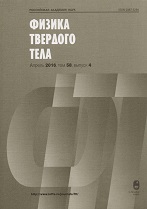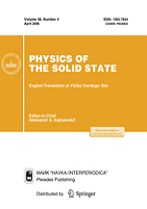|
Dielectrics
Quantum theory of the piezoelectric effect in rare-earth ferroborates
A. I. Popovab, D. I. Plokhovcd, A. K. Zvezdince
a National Research University of Electronic Technology, Moscow, Zelenograd, Russia
b Moscow Institute of Physics and Technology (National Research University), Dolgoprudny, Moscow Region, Russia
c Prokhorov General Physics Institute of the Russian Academy of Sciences, Moscow, Russia
d Peoples' Friendship University of Russia, Moscow, Russia
e P. N. Lebedev Physical Institute of the Russian Academy of Sciences, Moscow, Russia
Abstract:
Quantum theory of piezoelectric effect in rare-earth ferroborates has been developed. It was found that single-ion mechanisms are predominantly responsible for the effect: electric dipole moments are induced directly in the electronic 4$f$ shells of rare-earth ions in the presence of mechanical stresses in a crystal, which leads to the polarization of the crystal. The effect is quantitatively considered using the example of neodymium and samarium ferroborates, in particular, in the temperature range from 0 K to 300 K, the temperature dependences of piezoelectric modules are obtained. It is additionally shown that it is also possible for the crystal to become polarized along the crystallographic $c$-axis at the temperatures below the Néel point upon deformation of the crystal in a magnetic field. The temperature, field and orientation dependences of magnetically induced piezomodules are calculated.
Keywords:
piezoelectric effect, ferroborates, rare-earth ions, crystal field.
Received: 19.11.2020
Revised: 19.11.2020
Accepted: 20.11.2020
Citation:
A. I. Popov, D. I. Plokhov, A. K. Zvezdin, “Quantum theory of the piezoelectric effect in rare-earth ferroborates”, Fizika Tverdogo Tela, 63:3 (2021), 385–392; Phys. Solid State, 63:3 (2021), 477–484
Linking options:
https://www.mathnet.ru/eng/ftt8168 https://www.mathnet.ru/eng/ftt/v63/i3/p385
|


| Statistics & downloads: |
| Abstract page: | 99 | | Full-text PDF : | 104 |
|



 Contact us:
Contact us: Terms of Use
Terms of Use
 Registration to the website
Registration to the website Logotypes
Logotypes